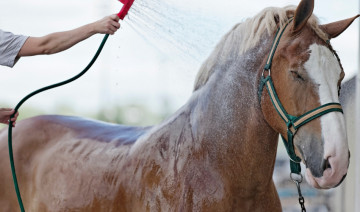
How Does Heat Stress Typically Impact Your Horse?
Heat stress can be dangerous for any animal. In horses, heat stress can lead to more severe reactions such as colic or heat stroke, which can be fatal. By recognizing heat stress and its impact, horse owners can more easily protect their equine companions and keep them comfortable when temperatures rise.
When Horses Are at Risk From Heat
Summer is the obvious time when horses are most at risk of heat stress, but it isn’t the only time when heat may impact a horse. Traveling can exacerbate heat stress as sunlight reflects mercilessly off asphalt and a horse trailer can seem like an oven. Horses in a barn or stable with inadequate ventilation or air circulation can suffer from heat, or a horse that is overexercised or subject to excess training can exhibit signs of heat stress. Any days where humidity is high can make heat seem more oppressive and heat stress more likely, especially if horses do not have access to shade or a cool place to rest.
Certain horses may also be more prone to heat stress. Senior horses cannot cool themselves as efficiently and might be stressed by heat even if it doesn’t seem likely, while overweight or out of condition horses are also more vulnerable to heat stress. Highly muscled horses may also have trouble cooling themselves well and can be subject to heat stress. Even horses in excellent condition might suffer from heat if they have recently been transported to a warmer region and haven’t had adequate time to adjust to the new climate.
Heat Stress Symptoms in Horses
Heat stress shows many subtle signs. While not every horses will show each sign at the same time, typical symptoms that indicate heat stress is impacting your horse include:
- Excessive sweating or lack of sweat even when overheated
- Dark-colored urine or inadequate urination
- Muscle weakness or trembling
- Stumbling and inability to maintain a gait
- Rapid breathing or blowing
- A fever of 102-106 (higher than 106 indicates more severe heat stroke)
- Loss of skin elasticity
- Sunken eyes
- Tacky membranes, including the gums or around the eyes
As soon as a horse starts to show these symptoms, treatment is essential to minimize the impact of heat stress and keep the animal from progressing to heat stroke.
Preventing Heat Stress
To manage and treat heat stress…
- Provide adequate fresh, cool water at all times so the horse has plenty to drink
- Offer grazing time in a lush, green pasture so the horse can get liquid from the grass
- Improve barn and stall ventilation with windows and fans to generate cross breezes
- Exercise or train the horse early or late in the day when the temperature is cooler
- Take the time for proper warm ups and cool downs to prevent stress
- Provide deep shade in the pasture so the horse has a cool place for resting
- Provide mineralized salt licks or blocks to encourage the horse to drink more
- Use lighter saddles, saddle pads, and other gear on hot days
- Allow the horse to wade through a pond or stream for more evaporative cooling
- Spray the horse with cool water for quicker, efficient cooling on hot days
The more techniques that can be used to keep the horse cool, the less the impact of heat stress will be on the animal. This is especially true for the most vulnerable animals or when the heat is rising dramatically. With care, however, it is possible to keep horses from suffering due to excess heat, and still enjoy thoughtful exercise and training even on hotter days.
